The technique of bronze casting with the help of moulds was invented during the Erligang period 二里岡文化 (1600-1400 BCE). The Zhou 周 (11th cent.-221 BCE) took over this skill, quite probably by seizing metal workers in the foundries of the Shang 商 (17th-11th cent. BCE). The technique and art of manufacturing decorated and inscribed bronze vessels spread from the Central Plain to all parts of the Zhou empire, and in practically all contemporary sites, ritual vessels were found. Yet the richest finds were made in the homeland of the Zhou – southern Shaanxi – and in Henan. Some regions developed their own tastes and styles.
North of the secondary capital Luoyang 洛陽, the remains of a furnace were found which was part of a workshop complex of no less than 10,000m2 size (Wu 1994: 176). The walls of the furnace were made of adobe bricks, had a diameter of 1.5m, and the furnace was heated with the help of bellows, of which a pottery tube has survived. With the help of bellows, temperatures above 1200°C could be reached.
Inscriptions on bronze vessels (mingwen 銘文, jinwen 金文), usually attached to the inner side, played in important role in Western-Zhou period 西周 (11th cent.-770 BCE) bronze vessels. They served to record the history of a family, for instance, by citing events like presents or appointments by the king of Zhou. Some texts were used as "propagandistic" material (Kern 2009: 152) to hail the virtuous government of the Zhou as it was sanctioned by Heaven (see Zhou religion), but also admonished the next generation and the regional rulers to stick to these principles.
Some inscriptions are testimonies of state history, like the Li gui 利簋 inscription which mentions King Wu's 周武王 annihilation of the Shang, the He zun 何尊 vessel which mentions King Cheng's 周成王 foundation of the eastern capital Luoyang, the Shi Qiang pan 史牆盤, which points at several highlights in the history of the early dynasty, or the Yi hou Ze gui 宜侯夨簋 found in Dantu 丹徒, Jiangsu, or vessels found in Liulihe 琉璃河 close to Beijing, where the lords of the regional state of Yan 燕 resided. All these inscriptions mention events of local history.
Even if early Western Zhou vessels resemble Shang-period vessels in shape and style, there are some differences, the most visible of which is the drastical decrease of wine vessels (jue 爵, gu 觚, jia 斝, zhi 觶). The Zhou believed that the immense consumption of wine for banquets or sacrifices was one reason for the downfall of the Shang – and therefore proclaimed the address Jiugao 酒誥 "Announcement on drunkenness", today a chapter of the Classic Shangshu 尚書 "Book of Documents". The traditional Shang wine vessels were replaced by ding 鼎 and gui 簋-type food vessels.
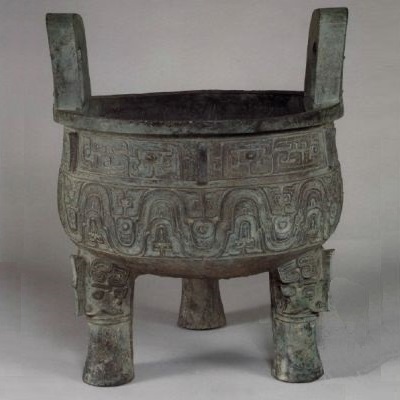 |
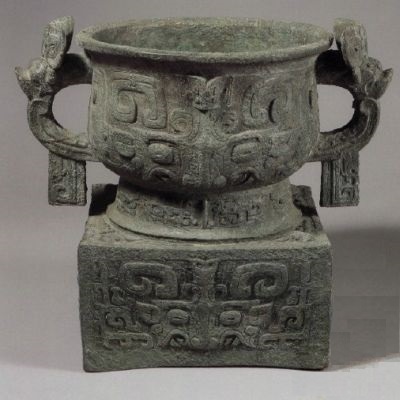 |
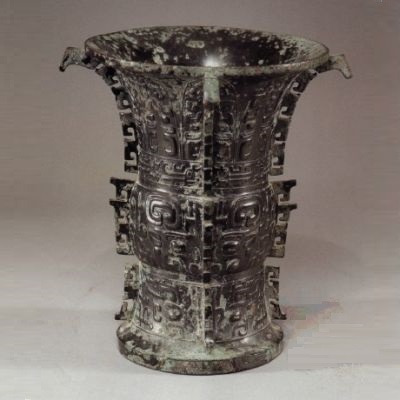 |
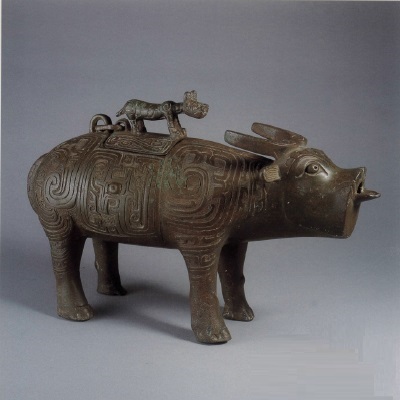 |
Top left: Tripod Da Ke ding 大克鼎, height 93cm, diameter 75cm. Top right: Cauldron Li gui 利簋 with a large square base, height 28cm, diameter 22cm. Bottom left: vase Shang zun 商尊, height 30cm, diameter 23cm. Bottom right: zun in the shape of a buffalo, height 24cm, length 38cm. The small cover has a knob in the shape of a tiger. From Zhongguo qingtongqi quanji bianji weiyuanhui 1996: Xizhou 1, nos. 31, 49, 153, 165. |
|
The largest vessel from the Western Zhou period found so far is the Hu gui 㝬簋, with a height of 59cm and a weight of 60kg (Wu 1994: 178). The ding tripods of this time had feet shapes like hooves which were rising into a lobed body (fendang 分襠), thus merging the traditional li 鬲 with the ding. The gui became a standard vessel, for which the Zhou invented a large square base (fangzuo gui 方座簋) which made this type of kettle very impressive. While ding typically had handles at the top of the rim, gui vessels were held by handles attached to the sides of the vessel body.
Novel features of decoration were "snails" with horns and beasts with wound-up bodies. Together with these patterns, birds became very popular as background decoration or as plastic protrusions in various parts of the vessels.
In rare occasions, zun 尊-type vessels - actually vases with a wide mouth - were given the shape of animals, like an elephant, a duck, or an owl. Quite outstanding are masks of human faces as decorative motifs on unearthed in Liulihe.
Apart from technical refinement, some stylistic changes took place during the mid-Western Zhou period. The shape of the ding tripod changed to a larger, wider, and lower appearance. Simultanously, the handles, once standing ontop the rim, sank somewhat down and were attached to the upper part of the body. New types of wine vessels appeared, namely lengthy xu 盨 and fu 簠, and the cubic fangyi 方彝, which resembles the shape of a small house. Finally, bird-and-beast patterns became more popular; decoration was simplified, and on the other hand, patterns became more diverse: the details of beast faces (shoumian 獸面) changed, wave patterns emerged, and patterns of fish scales.
 |
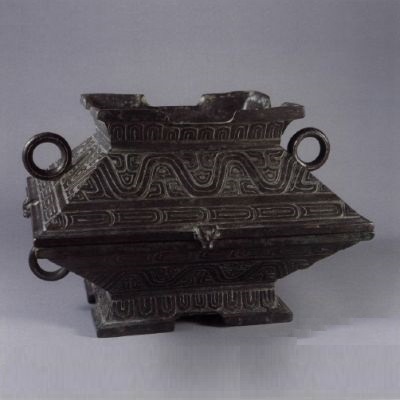 |
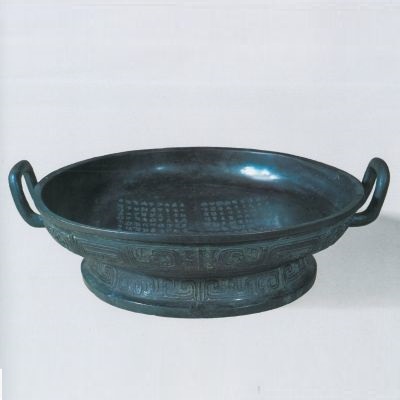 |
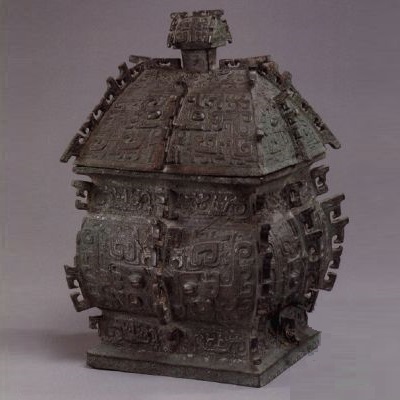 |
Top left: Container Bo Duo Fu xu 伯多父盨, height 21cm, length 25cm. Top right: Container Bo Gong Fu fu 伯公父簠, height 19cm, length 28cm. Bottom left: Plate Shi Qiang pan 史牆盤, diameter 16cm, height 7cm. Bottom right: Square container Qi fangyi 旂方彝, height 40cm, width 24cm. From Zhongguo qingtongqi quanji bianji weiyuanhui 1996: Xizhou 1, nos. 80, 83, 130, 198. |
|
In the late Western Zhou period, the system of vessel sets (lieding 列鼎) emerged in which several identical vessels (including the inscriptions) with different sizes were produced. The number and size of vessels expressed the status of its owner during sacrifices, banquets, or funeral rites. According to He Xiu's 何休 (129-182) commentary to a statement in the Classic Zuozhuan 左傳 (Huangong 桓公 2), the king was allowed 9 ding tripods (9 as the highest Yang 陽 number, see binary thinking), the regional rulers seven, ministers and grand masters five, high servicemen (yuanshi 元士) three, and lower servicemen only one (all impair numbers).
The number system of gui vessels followed the Yin 陰 group of numbers (pair): eight for the king, six for regional rulers, four for grand masters, and so on. This rule, too, was proven by excavations.
This numerical system was also applied to other objects, like li and you, and also to bronze bells. The higher their number, the more splendid the music played during the respective ceremonies, and thus expressing the status of the lord.
The whole empire strictly followed this system into the Spring and Autumn period 春秋 (770-5th cent. BCE). Some art historians are of the opinion that the "ritual reform" with its rule of identity in appearance and a backlash to simple, archaic forms prohibited further development in the realm of art (Wu 1994: 185).
Archaeology has basically proven this custom: The Xiao Ke ding 小克鼎 kettle, discovered in 1890, was realized in seven pieces, the duke of Guo 虢, whose tomb was found in Shangcunling 上村嶺 near Sanmenxia 三門峽, Hunan, seven, the master of a tomb in Rujiazhuang 茹家莊 near Baoji 寶鷄, Shaanxi, five, the lord of Puducun 普渡村 near Xi'an 西安, three (Wu 1994: 184).
Yet in many cases, the expression of the rank of nobility by certain numbers of sacrificial vessels was in reality not always adhered to in the late Western Zhou period. The hoard of Shan Shu 單叔 found in Yangjiacun 楊家村 in Meixian 眉縣, Shaanxi, included 12 ding and 9 li tripods (Shaanxi sheng kaogu yanjiu suo et al. 2003). Finds in Houma 侯馬, Shanxi, representing the nobility of the state of Jin 晉, and in Shangcunling, Henan, representing the statelet of Guo, also demonstrate that late Western-Zhou regional rulers used more sacrificial bronzes than allowed: they transgressed the boundaries of rituals.
Even in tombs of commoners, types of pottery vessels were found that were de jure only used by the nobility, namely dou 豆 beakers and hu 壺 pots, while the common folks were obliged made use of li 鬲 tripods, pen 盆 basins or guan 罐 jars. In this way, the "ritual rules" were made obsolete and were even used by those for which they had not been made.
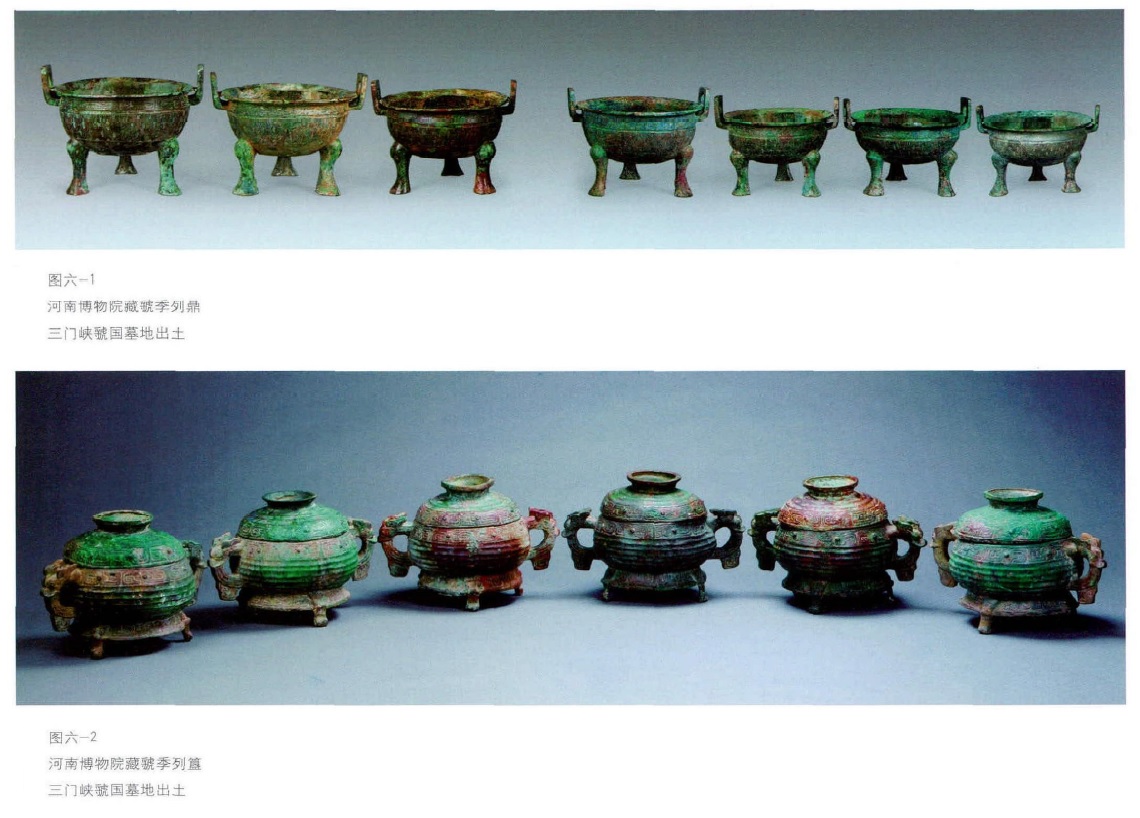 |
Set of seven ding 鼎 tripods and six gui 簋 containers unearthed in Shangcunling near Shaanxian, Henan, the site of the ancient state of Guo 虢. Height of ding kettles 25.5-39cm, that of gui vessles 22-23.3cm. From Tao (2015). |
The Zhou refined the range of bronze weapons in use in the 11th century. The shape of the ge 戈 dagger-axe was standardized by a large rear (yuan 援) and a hole by which the blade could be fastened tightly to a pole, in order to increase the lethal power of the weapon. The Zhou invented a cross-shaped halberd (ji 戟), some of which (inscribed) were found in Liulihe near Beijing and in Xincun 辛村 near Junxian 浚縣, Henan, the capital of the state of Wei 衛.
In Zhuyuangou near Baoji, archaeologists discovered three other types of military implements, namely a banner (mao 旄) with a pole, a metal head in the shape of a duck, and a bronze spike at the lower end (zun 鐏), used to fix the pole in the earth. The second was a ceremonial halberd or axe (yue 鉞) decorated with two tigers and a horned beast, while the eye for the pole (qiong 銎) was crowned with a human head. Such military paraphernalia as banners and (ceremonial) axe-halberds are mentioned in the "Book of Documents" (ch. Mushi 牧誓).
Chariots of the Shang period (see Shang military) were already furnished with quite a few bronze items, both necessary ones and decorations like bronze disks (tongpao 銅泡). Such metal parts became more common during the Western Zhou, and practically all finds of Western Zhou chariots include decorated linchpins, naves, or axle-caps, and some chariots were also decorated with small "phoenix bells" (luanling 鸞鈴). The wooden linchpin (xia 轄) was replaced by a bronze one and combined with bronze axle-caps (wei 軎). Horsegear also included many artfully decorated bronze parts. Chariots ready for use were thus not just a vehicle for warfare or hunting, but also a very impressive object underlining the status and wealth of its owner.
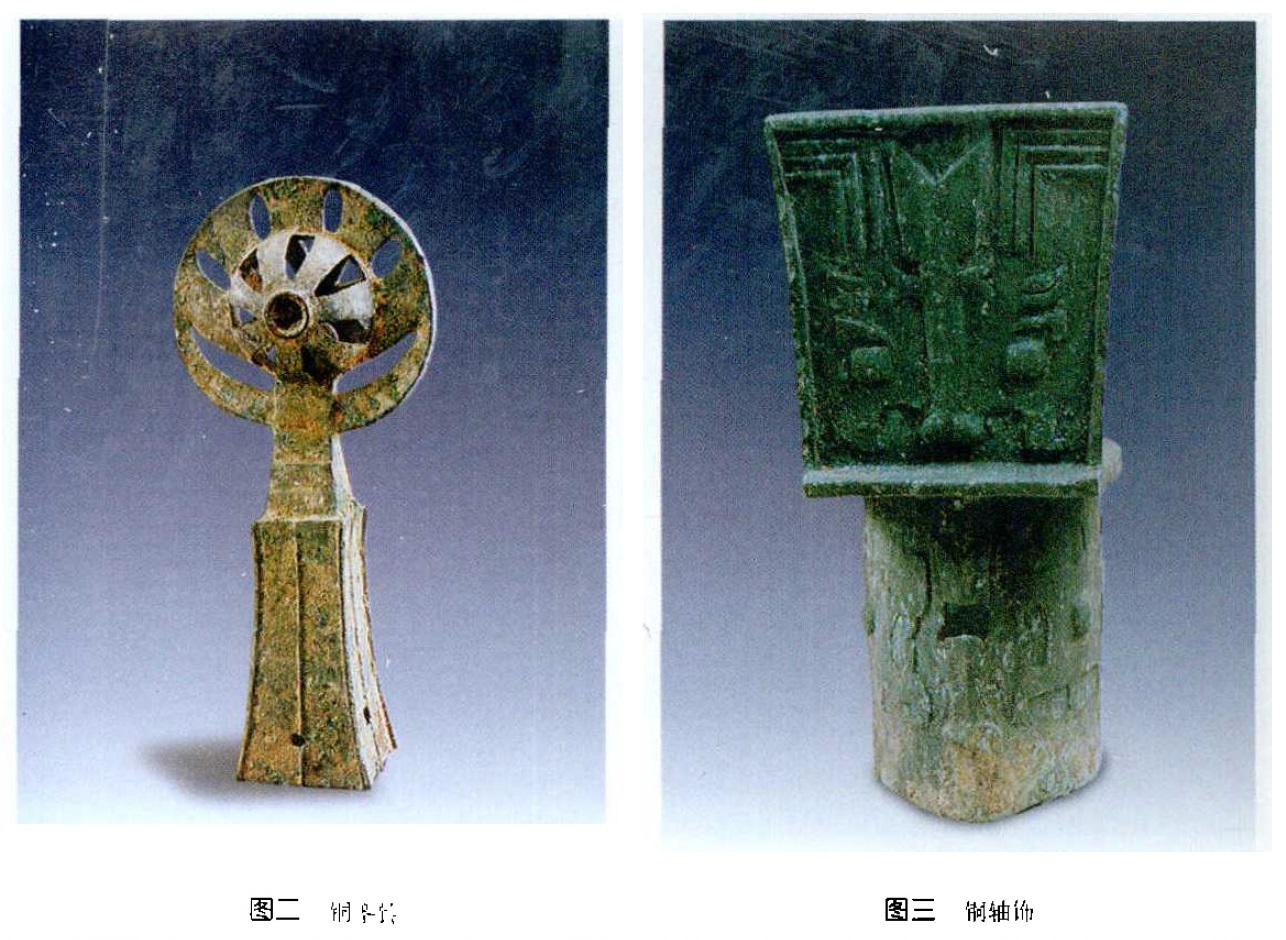 |
Left: Chimes (luanling 鑾鈴) attached to the axle, 19.2cm long, 11.4cm wide. The bell consists of a small bowl included in an open-work capsula. Right: adornment at the end of the axles (choushi 軸飾), length 20.7cm, width 10.7cm, decorated with a taotie 饕餮 mask. Source: Wang 2002: 5. |
Based on hundreds of years of experience, Western Zhou artisans perfected the technique of carving in various materials, from clay to bones, shells, ivory, jades and other stones.
Even if bones belonged to the most widespread material for making tools for everyday life - as can be seen in the excavation of bone workshops in the Feng-Hao 豐鎬 region near Xi'an 西安, Shaanxi, decorations on bone objects are rare. Quite outstanding are two combs found in a tomb in Zhuyuangou, Baoji.
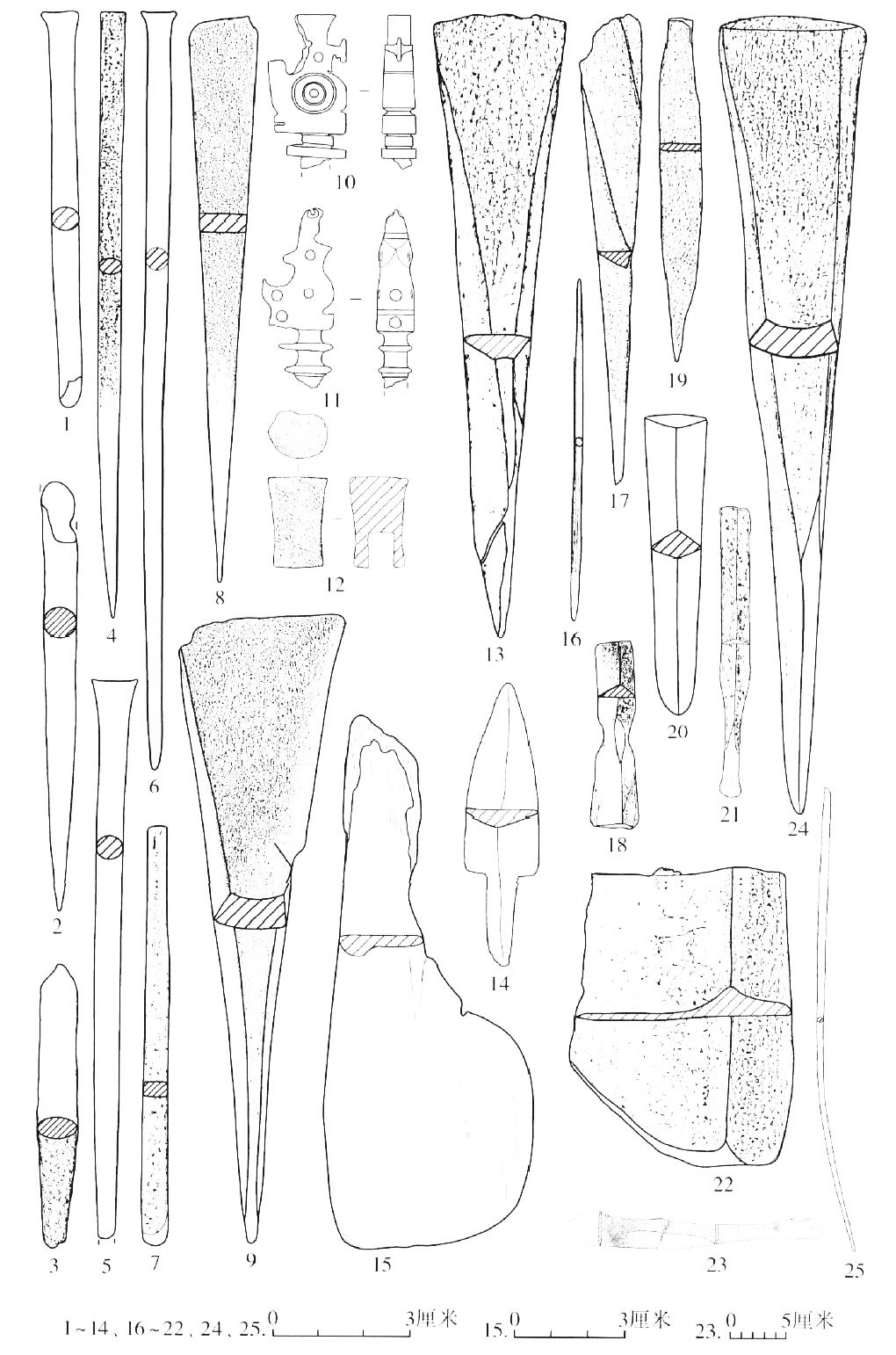 |
Carved bones for daily use, among them tools like awls (zhui 錐, 2, 8-9, 13, 17, 19, 24), arrowheads (zu 鏃, 3, 14), a cutter (dao 刀, 15), ladles (shao 勺, 21, 23), a stylus (qian 簽, 16) or decorative objects like hairpins (ji 笄, 1, 4-6, 10-12), as well as unidentified objects (7, 18, 20, 22, 25). Found in the remains of a Western Zhou-period workshop in the village of Fengcun 馮村 in Chang'an District 長安區, Xi'an, Shaanxi. From Zhongguo shehui kexue yuan kaogu yanjiusuo Feng-Hao dui 2014: 40. |
In the building of Zhaochengcun 召陳村, Fufeng 扶風, Shaanxi, archaeologists unearthed two pieces of clam shells carved in the shape of human heads with a height of 2-3cm, perhaps symbolizing the figures of religious mediums (wu 巫). In Zhuyuangou and Rujiazhuang, Baoji, shell carvings in the shape of a fish and an oxhead were found (Wu 1994: 174). In Zhangjiapo 張家坡, a 29cm-long spoon made of ivory came to light. It is carved with dragon (kuilong 夔龍) decorations. A hairpin (ji 笄) of ivory was discovered in a tomb in Zhuyuangou. In Baifu 白浮 near Changping 昌平, Beijing, an ivory comb decorated with a taotie 饕餮 mask, and a bodkin (xi 觽) of ivory, were excavated.
The interest in jade carving somewhat declined during the early Western Zhou period, perhaps because the Zhou immensely profited from booty jade they had made from the Shang (Zhou 2000: 447), and because bronze became a more widespread tool (Zhou 2008: 59). Yet the amount of carved jade skyrocketed again from the 9th century on. Nephrite pieces were carved into the shape of the "six ritual jades" (liuruiyu 六瑞玉), namely discs (bi 璧), square tubes (cong 琮), symmetric plaques with a pointed tip (gui 圭, "sceptres"), asymmetric "sceptres" (zhang 璋), segments of rings or "arcs" (huang 璜), and tiger-shaped objects (hu 琥), or to other shapes like nearly closed rings (jue 玦). They were decorated with geometrical patterns like bows, stripes, or scales, and zoomorphical designs like dragons, tigers, and birds (Zhou 2008: 74-76). The number of artwork to wear on the head, pendants (pei 珮, also written 佩) at the girdle, or such around the neck or the fingers increased. Quite impressive are the necklaces found in Quwo 曲沃, Shaanxi, and in Shangcunling, Henan. They consisted of ring segements, beads, and short tubes of various precious stones. Tombs in Zhangjiapo near Xi'an and in Quwo included carved pieces of jade which covered the orifices of a corpse (eyes, ears, mouth, nose) and were shaped in the form of the respective organs. Other typical jade items were ge dagger-axes.
Quite interesting is jade artwork differing from these ritual implements, namely jades carved to figurines of humans or animals. Human figurines were found in Luoyang and Baicaopo 白草坡 near Lingtai 靈臺, Gansu, the latter perhaps depicting a non-Chinese person. Jade pieces with animal shapes were quite widespread: birds, beasts, deer, tortoises, and even silkworms.
A general trend of Western Zhou jades was to diminish the size and number of ritual jades, including that of ge dagger-axes. Simultaneously, the number of animal-shaped pieces shrank, and the number of mythological animals used for adornments increased, particularly for pendants. In dragon decorations, the animal's eyes became a focus of artwork which gives the impression that the Zhou laid greater importance on appearance than on symbolic meaning (Zhou 2008: 77-78).
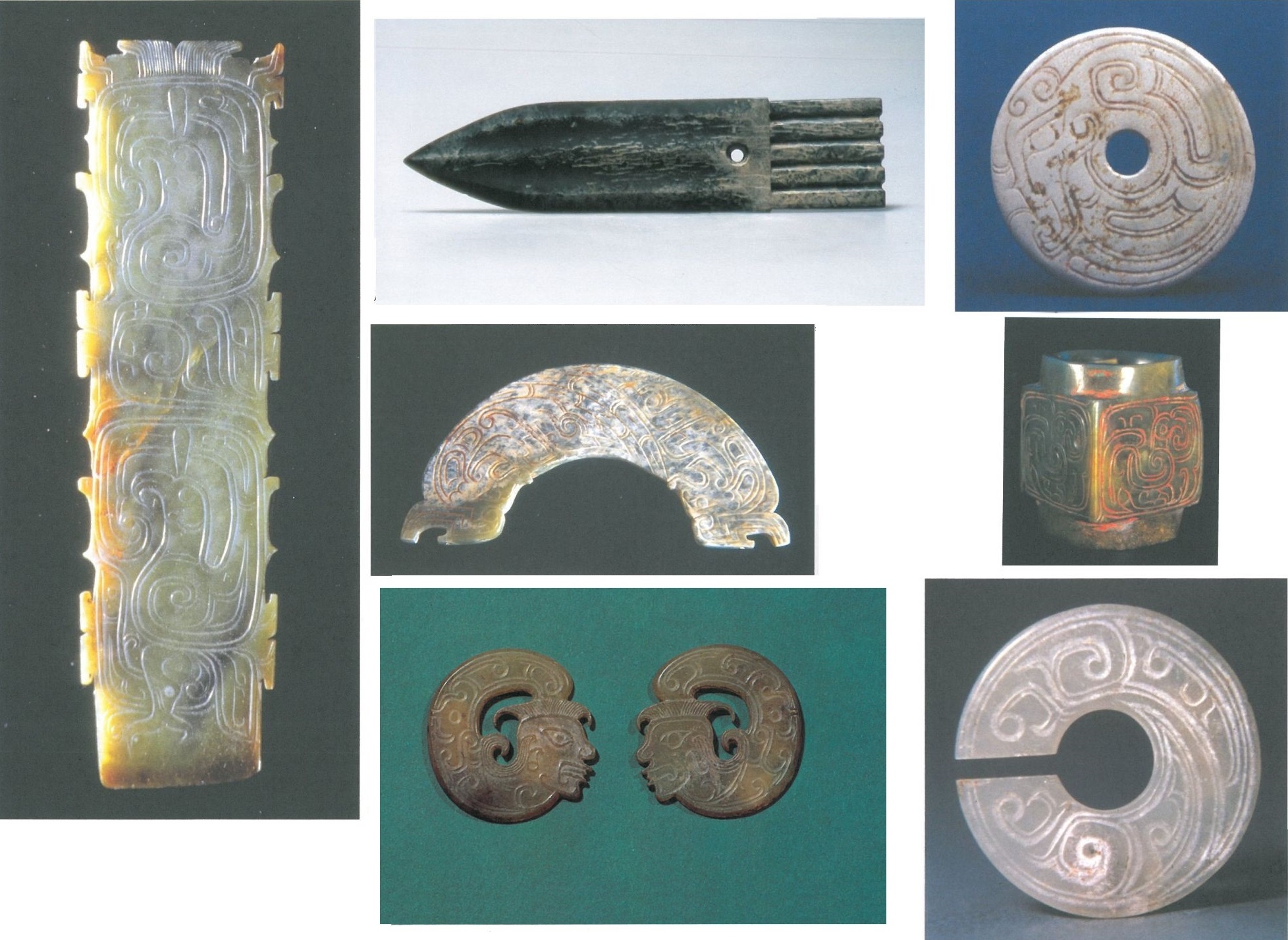 |
Various jade objects from the Western Zhou period. Left: Jade "sceptre" or "knife" with bird-pattern carving, length 13.6cm. Middle column: Ge 戈-type dagger axe, length 25.4cm; huang 璜 circle with dragon patterns, width 13cm; pair of circles showing snake-like animals with android heads, early Spring and Autumn period, diameter 3,8cm. Right column: White jade bi 璧 disk with dragon pattern, diameter 14.8cm. Cong 琮 tube, engravings coloured with cinnabar, height 5.5cm. Jue 玦-type circle with slit, diameter 4.4cm. From Zhongguo meishu quanji bianji weiyuanhui, Yang 1986; Zhou, Zhongguo Wenxu Xuehui Zhuanjia Weiyuanhui 2008. |
The amount of high-fired pottery found in Western Zhou sites is larger than during the Shang. The fragments of dou 豆 and guan 罐 vessels found in Zhangjiapo near Xi'an demonstrate that this type of proto-porcelain consisted of a grayish shard with green or yellowish glaze. One of the best pieces surviving is a greenish-glazed dou from Puducun not far away. Similar finds were made in Fengchu 鳳雛, district of Qishan 岐山, and in Rujiazhuangnear Baoji.
The amount of proto-porcelain found in Western Zhou tombs of Luoyang is considerable. Apart from dou vessels, the traditional pottery types of gui, lei and weng 甕 were also realized as high-fired earthenware. Some of the pieces were not just glazed, but also decorated with geometrical patterns, for instance, "clouds" or spirals (yunlei 雲雷).
Such high quality earthenware was not a privilege of the king. Glazed hard-fired earthenware was also found in Liulihe (regional state of Yan) or the southern region like in Yandunshan 煙墩山 near Dantu 丹徒, Jiangsu, Tunxi 屯溪, Anhui, and even in Baicaopo, Gansu.
The southern tombs show that the technique of firing earthenware was in south China more advanced than in the north. This has mainly to do with kaolinite deposits, which are richer in the south.
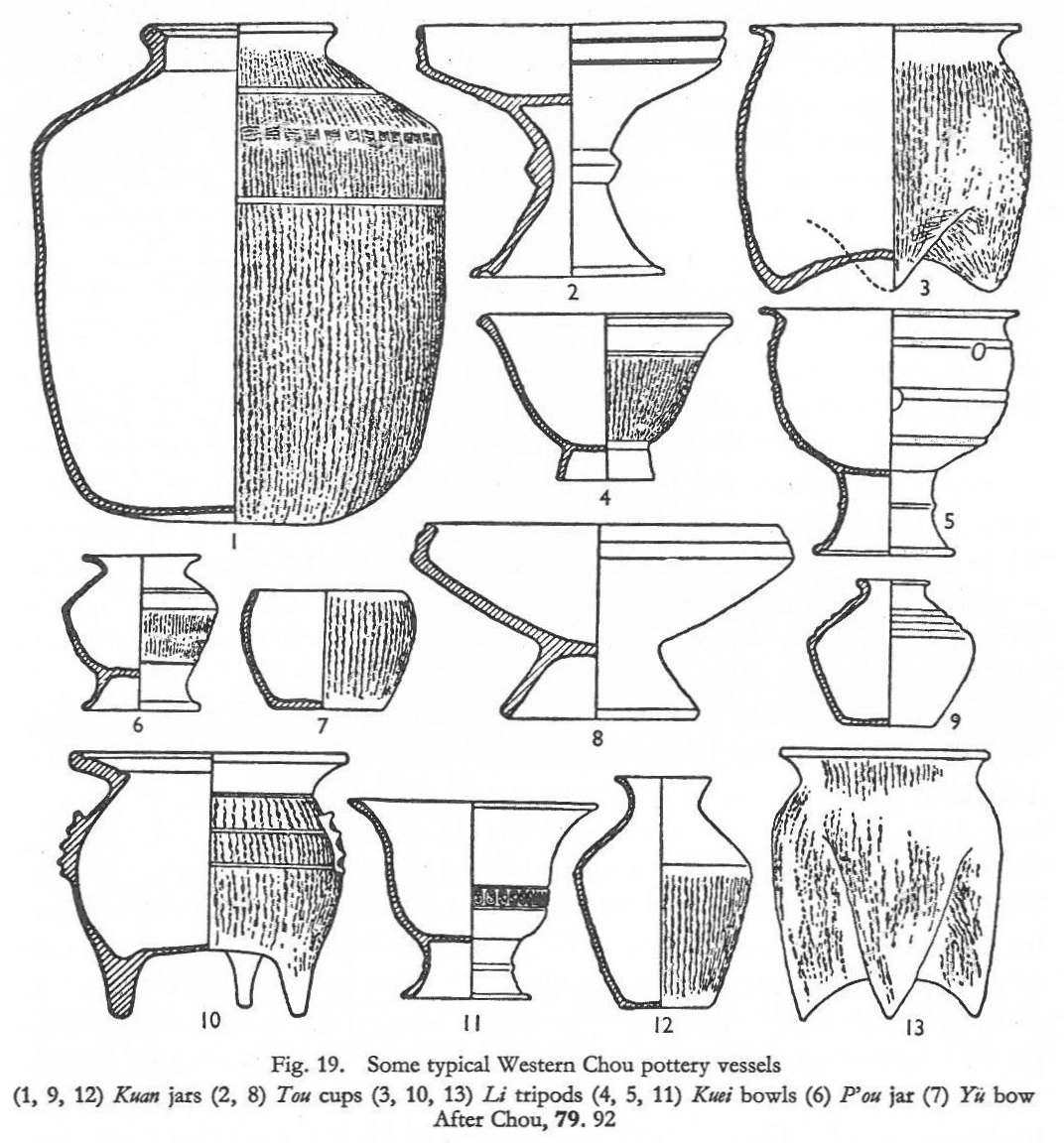 |
Typical pottery from the Western Zhou period. Most shapes are continuations of Shang-period types: guan 罐 jars (1, 9, 12), dou 豆 cups (2, 8), li 鬲 tripods (3, 10, 13), gui 簋/𣪕 bowls (4, 5, 11), pou 瓿 jars (6), and yu 盂 receptacles (7). From Cheng 1963. |
The art of coating or decorating wooden objects with the coloured varnish of the lacquer tree was already known during the Shang, but only a very low number of fragments has survived. The Zhou expanded the use of lacquerware even to ritual ceremonies and combined lacquering with incrustations. Apart from wooden vessels like dou, Zhou artisans also lacquered boxes, small tables, musical instruments, chariots and coffins. The use of lacquerware is attested in the Classic Shijing 詩經 "Book of Songs" (Yongfeng 鄘風, Ding zhi fang zhong 定之方中). The ritual Classic Zhouli 周禮 defines which colours the various ranks of the nobility were allowed to lacquer their chariots and coaches with (part Chunguan 春官, ch. Jinche 巾車; part Kaogongji, ch. Lunren 輪人).
The oldest lacquered parts of a chariot were found in Doujitai 鬬雞臺 near Baoji. The site of Shangcunling near Sanmenxia, Henan, which was the seat of the lords of Guo, included four plain wooden dou vessels lacquered in black. The rim was decorated with disks of clam shell (bengpao 蚌泡). Similar objects were found in Xincun, Henan.
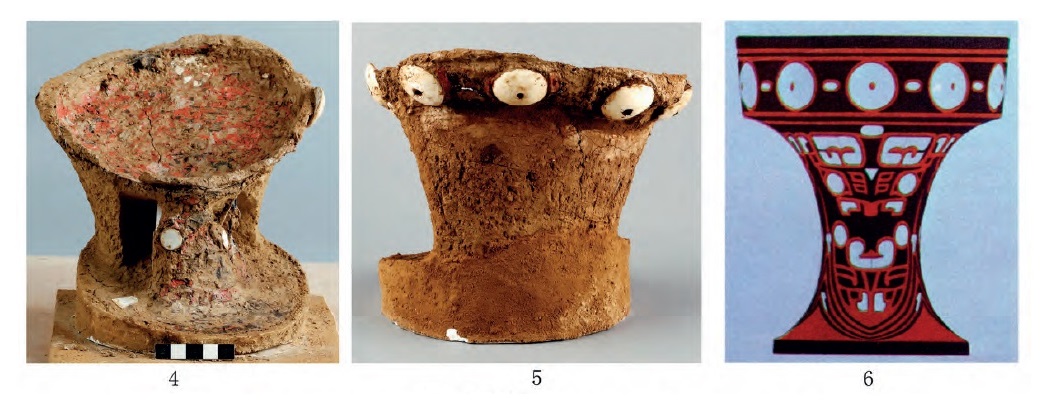 |
Remains of lacquered wooden dou 豆 vessels decorated with disks of clam shell, nearthed in Dahekou 大河口 near Yicheng 翼城, Shanxi. Reconstruction of a dou found in Liulihe 琉璃河 near Beijing (right). U. From Hong 2018: 79. |
In the 1970s, a large number of imprints of lacquerware (or just the remains of the coating, qipi 漆皮) was discovered in the tombs of Hejiacun 賀家村 and Qijiacun 齊家村 in Qishan, Shaanxi. The colour was red and black and patterns of beast faces (shoumian 獸面) were recognizable, but the bodies of the vessels, chariot parts, and coffins have decayed. Taotie masks and shell disks were found as decorations of boxes and dou vessels in a tomb in Yuntang 雲塘, Fufeng. It might be that the bodies of lacquered objects were not just wood, but there might also have been leather or textile undergrounds (Wu 2004: 203).
Deformed lacquerware in the shape of gu, dou, and lei, was found in the site of Lilulihe. They were lacquered in red and decorated with shell disks and turquois stones. The gu vessel as decorated with black patterns of dragons (kuilong), while the colours were inverted in case of the dou: Black background, and red decorations. The designs were similar to those of bronze vessels.
Apart from the vessels, an oblong lacquered shield (dunpai 盾牌) was discovered.
Three gold foils (jinbo 金箔) with embossed patterns were found in the site of Fengchu, Qishan. Yet similar objects were also found in other places. Gold foil was attached (tiejin 貼金) to spears, chariot parts or bronze objects.
Glass material (liaoqi 料器) was found in quite a few Western Zhou tombs. It was made of lead-barium glass, and not of soda-lime glass known in the Roman empire. Green glass pearls (boli zhu 玻璃珠) and white perforated pearls were discovered in Luoyang, similar objects in the Feng-Hao area near Xi'an, Shangcunling near Shaanxian, in Hejiazhuang near Qishan, Yuntang near Fufeng, and in tombs of Rujiazhuang near Baoji. The latter site contained glass objects in pearl shape, rhomboids, and tubes. They were grayish or green-gray and combined with agates or jades to form necklaces or other adornments. Some of the glass objects were shiny, others not, and some of them were nearly transparent, even if the greater number was opaque (Qin et al. 2016).
The Western Zhou had a clear cosmological concept about colours. The application of colours for the decoration of court robes is described in the paragraph Huahui 畫繢 in the text Kaogongji, today a chapter of the ritual Classic Zhouli.
| 東方謂之青,南方謂之赤,西方謂之白,北方謂之黑,天謂之玄,地謂之黃。 | The east corresponds to the colour blue, the south to red, the west to white, the north to black; the colour of Heaven is purple-black, and that of the earth is yellow. |
| 青與白相次也;赤與黑相次也,玄與黃相次也。 | Blue is well combined with white, red with black, and purple-black with yellow. |
| 青與赤謂之文,赤與白謂之章,白與黑謂之黼,黑與青謂之黻,五采備謂之繡。 | Blue and red are called "regular embroidery", red and white "variegated embroidery", white and black "fǔ 黼", black and blue "fù 黻", and a combination of all these colours is called "mélange". |
| 土以黃,其象方,天時變,火以圜,山以章,水以龍,鳥獸蛇。 | The earth is represented by yellow, its symbol is a square, and it changes according to the seasons ; fire is represented by a circle, mountain by a plateau, water by a dragon, and birds, beasts, and snakes [are represented as in nature]. |
| 雜四時五色之位以章之,謂之巧。 | When combining the five colours through the four seasons in order to stress their brilliance, this is called mastery. |
According to Édouard Biot, Vol. 2, 514-516. |
|
Combinations of colours were black and white found on a pottery vessel unearthed in Zhangjiapo near Xi'an. A bronze instrument for preparing colours was found in Hejiacun, Qishan. It consists of a round chest and four tube-like containers (Wu 2004: 171). In the same site, fragments of a coloured linen textile were found. A tomb in Rujiazhuang, Baoji, contained a piece of textile woven of red and yellow yarns. Fragments of coloured yarn were also discovered in a tomb in the Feng-Hao area.
Examples of wall painting have not been discovered so far, yet a description of the Mingtang Hall 明堂 in the ritual Classic Liji 禮記 speaks of such paintings.
"Calligraphy" as a style of writing became important during the Western Zhou period, as the number of inscriptions on bronze vessels increased, and at the same time the length and concent of inscriptions vastly expanded. To date, more than 3,000 inscribed bronze vessels were discovered or registered, half of which is dated to the Western Zhou period. While the number of characters on Shang-period vessels does barely surpass a dozen, Zhou inscriptions were often much longer. The vessel with the longest inscriptions is the Mao gong ding 毛公鼎 tripod (with nearly 500 characters), dating from the middle Western Zhou period. The inscriptions mention name, rank, and function of the vessel owner, the ceremonial occasion of an appointment, presents by the king, the place where the ceremony took place, hints to the historical context, and in quite a few cases a short address by the king. The inscriptions served as "archives" of the glory of noble families.
Theoreticians of calligraphy called the writing style of bronze vessel inscriptions "large seal script" (dazhuanti 大篆體, zhouwen 籀文 or zhoushu 籀書). The word zhou 籀 was the name of the office of scribe introduced under King Xuan 周宣王. It is assumed that the inscription was written with ink on the model of a bronze vessel (always in the inner part of the object), then carved into the body, and so transmitted into the mould. The form of large seal script characters is uniform with no thinner or thicker parts, and the composition of each character arranged in a way that each character had approximately the same size.
The earliest example of a Western Zhou inscription is that of the Li gui 利簋 (Jicheng 4131) which mentions the Zhou conquest of the Shang kingdom. The writing style of this inscription served as a model for the next generations, like the Ze ling fangyi 夨令方彝 (Jicheng 9901) and Bao you 保卣 (Jicheng 5415) of King Cheng's reign or the inscriptions on the Da Yu ding 大盂鼎 (Jicheng 2837) and Da Fang ding 大方鼎 (Jicheng 2759) from the reign of King Kang 周康王. The characteristics of this style is that some parts of the characters are thicker than others, and so reflect the movement of the brush which originally wrote the characters on the model. This style is called bozheti 波磔體 "waved straight strokes".
The trend intensified during the mid-Western Zhou period which is seen as a time when a standard of bronze inscriptions crystallized. Strokes became coarser and showed at their ends so-called "ink clusters" (motuan 墨團). Experts used to call this style "jade stress" (yuzhuti 玉箸體). The most important examples of it are seen in the inscriptions of the Zongzhou zhong 宗周鐘 bell (also called Hu zhong 㝬鐘; Jicheng 260) from the reign of King Zhao 周昭王, Dong ding {戈/冬}鼎, Yu bo gui 𢐗伯簋 from the time of King Kang, or the Shi Qiang pan 史牆盤 plate (Jicheng 10175), Yong yu 永盂 (Jicheng 10322), Qiu Wei he 裘衛盉 (Jicheng 9456) from the time of King Gong 周共王, Shi hu gui 師虎簋 (Jicheng 4316 King Yi) or Da Ke ding 大克鼎 from the time of King Xiao 周孝王. The long inscription of the Shi Qiang pan with its regular austerity and round, pleasant characters is a paradigm of the combination of high literature and calligraphy.
In the late Western Zhou period, the styles became more diverse like the regular and harmonious inscriptions of the Mao Gong ding or Hu gui 㝬簋 (also written 胡簋; Jicheng 4317), or the energetic and sophisticated style of the Sanshi pan 散氏盤 (Jicheng 10176) or Guo Jizi Bo pan 虢季子白盤 (Jicheng 10173).
From the mid-Western Zhou period, inscriptions were made more public by not just inscribing them on the inner side of vessels (visible only to the ancestral spirits during sacrifices), but on the open space of pan 盤 plates.
The architecture of the Zhou can be divided into two types, namely the original Zhou style used in their homeland in the Zhouyuan Plain around Baoji, Fufeng and Qishan, and the other style found in the "metropolitan" area of Feng and Hao close to Xi'an. The word jing 京 "lofty, great" is of Zhou origin and was their word for residence or settlement where the Shang had used the word yi 邑 (Wu 1994: 196).
The foundations of buildings excavated in Fengchu, district of Fufeng, might have been part of the earliest settlement of the Zhou. Traces of a city or citywalls have not been found. The temple or palace complex of Fengchu was erected on a pounded-earth platform and has a dimension of 45×32m. The complex consists of a main hall (qiantang 前堂, 17×6m), two smaller back halls, a large courtyard before and a smaller one behind the main hall, and an entrance construction separated by a gate. The complex thus corresponds to the model of the traditional siheyuan 四合院, a couryard surrounded by four sides, with the main buildings located opposite to the entrance. The two courtyards of Fengchu were dewatered by canals of earthenware tubes. Before the entrance gate, a wall protected the complex from the influence of bad spirits.
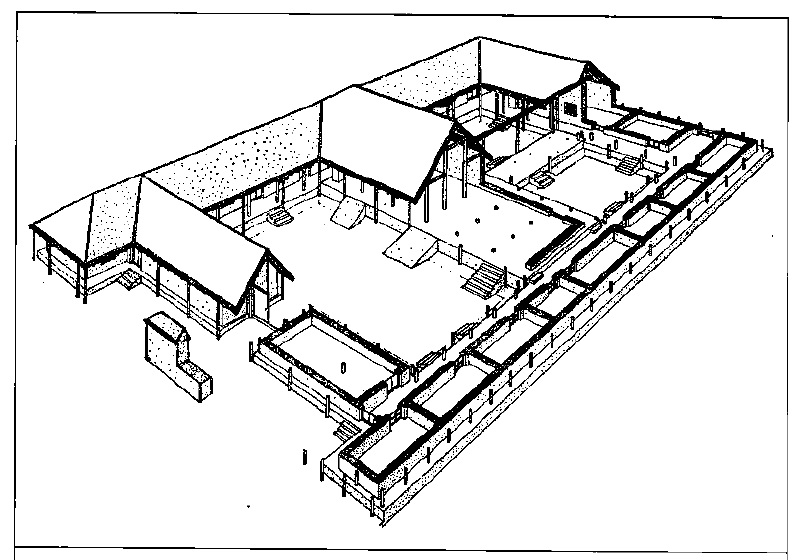 |
Reconstruction of the temple-palace complex in Fengchu, Shaanxi. It can be seen that the traditional composition of halls and colonnades standing on elevated platforms and grouped around courtyards is already fully developed during the Western Zhou period, even if the roofs might not have been as impressive as in later buildings. From Zhongguo shehui kexue yuan kaogu yanjiusuo 2004: 58. |
Not far away, a complex of 15 buildings was discovered in Zhaochen. They can be dated to two periods. Building 3 is 24×15m-large. Its interior was divided into several compartments of "rooms".
The most outstanding feature of these buildings on contrast to Shang-period buildings is the use of tiles to cover the roofs. The tiles were held in several forms, one almost a half-tube (tongwa 筒瓦), the second type only slightly bent (banwa 板瓦), and the third type to flush with the eaves (banwadang 半瓦當). The tiles were decorated with rope patterns. Some of the tiles were apparently able to be fastened one against the other, while a more simple type was just pasted on the loam roof with the help of nail-like (wading 瓦釘) or ring-like (wahuan 瓦環) protrusions (197). Some tiles were quite large, with a dimension of 45×30cm (Wu 1994: 199).
The walls of the buildings in Fengchu and Zhaochen consisted of two types, namely stamped-earth walls and such made of adobe bricks (tupi 土坏). Stamped earth was created by tying together five tampers (hangchui 夯錘). Apart from pillars carrying the centre of the roof construction, some buildings had pillars to carry overhanging eaves (qingyanzhu 擎檐柱) (Wu 1994: 197).
The floor of some buildings was decorated with pebbles in different colours, in order to give inhabitants, guests or users some impression of beauty. In the buildings of Zhaochen, carved white jade was found which might have been used as wall decoration. Clam shells were also used as decorations, and some of them were carved to disks (bengpao) or even decorated with zoomorphical taotie or with geometrical patterns. Others were held square and arranged in decorative patterns (Wu 1994: 198).
The metropolitan region of the residences Feng and Hao on the western and eastern banks of River Feng was the political centre of the early Zhou empire. Many archaeological remains were found in the villages around, but there is nothing like a great central palace or a city wall. Any description of the royal residence like found in the text Kaogongji is therefore a somewhat idealized picture. This is also true for descriptions of the royal capital as found in the historiographical text Chunqiu-Zuozhuan 春秋左傳 or the ritual Classic Liji. There is talk of a palace with five gates and three great halls. The Liji speaks of certain parts of the palace which only the king and the regional lords were allowed to enter by passing the Terrace Gate (taimen 臺門). Decorative colours were reserved for certain ranks: red for the king, black for the regional rulers, green for the Grand Masters, and yellow for the servicemen. No prove for such statements have found so far.
West of River Feng 灃, in the villages of Mawangcun 馬王村 and Keshengzhuang 客省莊, several buildings with pounded-earth foundations were found, among them a large building of 61×35m. The dwellings of the commoners were semi-subterranean. In Liulihe, southwest of Beijing, the capital city of the regional rulers of the state of Yan was found. The wall around the settlement was 800×300m-long and consisted of pounded earth with a width of 10m. Outside of the wall was a moat. While several buildings with pounded-earth foundations were discovered inside the city, the tombs were located outside, among them those of some marquesses of Yan which included beautiful bronze vessels.
In southern China, people used to build stilt houses (ganlanshi jianzhu 干欄式建築), as can be seen in the site of Maojiazui 毛家嘴 in Jichun 蘄春, Hubei. One house with a diameter of c. 20m was standing on 109 stilts, while the outer rim was surrounded by wooden boards (Wu 1994: 200).
Music was an important aspect of court rituals, for which reason the Zhou set up several offices concerned with the arrangement and performance of music during audiences, banquets, ritual performances like archery contests and sacrifices. As with many rituals matters, the Duke of Zhou is credited with having arranged the typical early Zhou style of music (Wu 1994: 190). The music master (dashi 大師, dasiyue 大司樂) was subject to the Ministry of Spring, as listed in the ritual Classic Zhouli.
The earliest testimony of Zhou period music is the collection Shijing "Book of Songs" which in its transmitted form includes airs (feng 風), odes (ya 雅), and hymns (song 頌), the first type performed in the various regional states, the second one at the Zhou court, and the third type in the royal temples of the royal houses of the Shang and Zhou or their descendants, respectively – at least, the Song-period 宋 (960-1279) scholar Zheng Qiao 鄭樵 (1104-1162) said so in his encyclopaedia Tongzhi 通志. The first group of songs, called Guofeng 國風 "Airs of the states", was believed to be music from among the people (minge 民歌) collected by administrators of the Zhou musical institution. The odes of the last part hail the virtue of the Zhou kings and describe how and why they were able to overcome the Shang.
Confucius is said to have polished and newly arranged this collection, coming to a 305 pieces whose texts are transmitted today. The Warring States period master Mozi 墨子 alleges (Mozi 墨子, ch. Gongmeng 公孟) that the collection originally included 300 recitation pieces (song 誦), 300 accompanied by zithers (xian 弦), 300 songs (ge 歌), and 300 dances (wu 舞). Whether melodies were ever written down, is unknown and rather unprobably, but the music – perhaps transmitted just by practical teaching - went lost during the Qin period 秦 (221-206 BCE).
The number of musical instruments mentioned in the "Songs" is impressive, and reaches from the omnipresent bells and drums used during the great state ceremonies and during war, to various string instruments, soundstones, flutes and ocarinas to scrapers. The Zhou divided musical instruments not according the way of how tones were produced, but according to the material: metal, stone, earth, leather, silk, wood, gourd, and bamboo – together the "eight timbres" (ba yin 八音).
Bells were perhaps the most complex musical instrument of the Zhou. The zhong 鐘-type bell was developed out of the clapperless nao 鐃 of the Shang period. The mastering of producing bells with a perfect sound required greatest diligence in the design of the bell parts. The text Kaogongji, today a chapter of the Zhouli, describes all the features the bell master (fushi 鳧氏) had to check. The most advanced types of bells came from the lands in the middle Yangtze region. Zhong bells could produce two sounds, one when beating the centre of the drum, the other one when strucking its periphereal area. Bells were usually grouped to carillons (bianzhong 編鐘) ranging from small sets (si 肆) with three as found in Zhuyuangou 竹園溝 in Fufeng, to larger sets with eight bells.
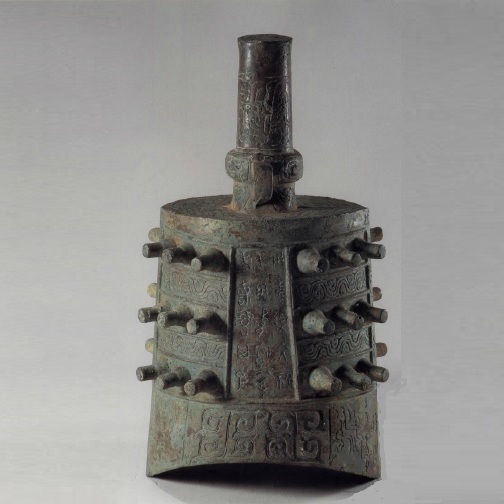 |
sss |
Bell Jing (=Xing) shu zhong 井(=邢)叔鐘, height 37cm, width at base 20cm. From Zhongguo qingtongqi quanji bianji weiyuanhui 1996: Xizhou 1, no. 184. |
|
In the mid-Western Zhou period, bells became fashionable at all courts, and their shape and sounds were refined. Bells became longer, and the number of decorative knobs increased. In addition, loops were added so as to hang up the bells on racks instead of holding them in the hand (Rawson 1999: 428).
Concerning dances, the Zhou were somewhat conservative, and preserved the older "great dances" (dawu 大舞, liudai wu 六代舞, liuwu 六舞) Yunmen 雲門, Daxian 大咸, Jiushao 九韶, Daxia 大夏, Dahuo 大濩, and added just one "martial" dance (Dawu 大武) after their victory over the Shang. The older dances were said to derive from the Shang and Xia 夏 (21th-17th cent. BCE) dynasties and the mythological emperors. Each of these dances was accompanied with bells in different tones and in different keys. Each dance had a singulary purpose and was performed only during particular sacrifices (see also Zhou religion).
| dance | key of music | key of chant | worship |
|---|---|---|---|
| Yunmen 雲門 | huangzhong 黃鍾 | dalü 大呂 | Heaven |
| Daxian 大咸 | dacu 大蔟 | yingzhong 應鍾 | Earth |
| Jiushao 九韶 | guxian 姑洗 | nanlü 南呂 | four cardinal directions |
| Daxia 大夏 | ruibin 蕤賓 | lingzhong 函鍾(林鐘) | mountains, rivers |
| Dahuo 大濩 | yize 夷則 | zhonglü 小呂(仲呂) | ancestresses |
| Dawu 大武 | wuyi 無射 | jiazhong 夾鍾 | ancestors |
How the Dawu "Great Martial Dance" was executed is described in the text Yueji 樂記 which is transmitted as a chapter of the ritual Classic Liji (ch. 19).
The "lesser dances" (xiaowu 小舞) were performed at the court of the regional lords. The names (fuwu 帗舞, yuwu 羽舞, huangwu 皇舞, maowu 旄舞, ganwu 干舞, renwu 人舞) and characteristics of some dances are known. The dancers often held feathers in their hands to support the visuality of their movements and reverences to the particular spirit to which the dance was dedicated.
The ritual prescriptions of the Western Zhou allowed the king four bell racks (wang gongxian 王宮縣[=懸]), the regional lords just three (zhuhou xuanxian 諸侯軒縣), the ministers and grand masters two (qing dafu panxian 卿大夫判縣), and the servicemen just one rack (shi texian 士特縣; Zhouli, ch. Xiaoxu 小胥). The number of dancer troupes (yi 佾, with 8 persons) was also restricted with 8 troupes for the king, 6 for the regional lords, 4 for ministers and grand masters, and 2 for servicemen.
Not belonging to the group of grand and lesser dances were the dances xiangwu 象舞 "elephant or idol dance", tiangongwu 天弓舞 "dance of the Heavenly bow", or the "scattered music" (sanyue 散樂) not related to court activities.
Two tombs in Rujiazhuang near Baoji, occupied by the remains of the lord of Yu 𢐗 and his consort, included figurines of dancers, one male, and one female. Some of the nine accompanying persons buried in of the tombs along with the tomb owner might have been dancers. (Wu 1994: 194).